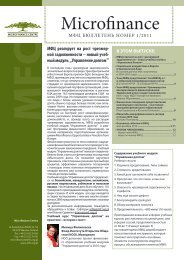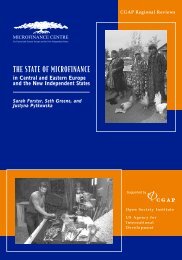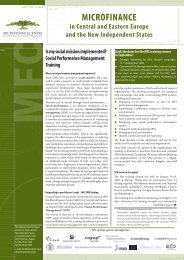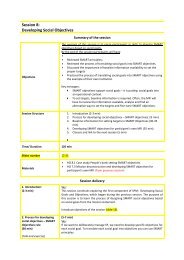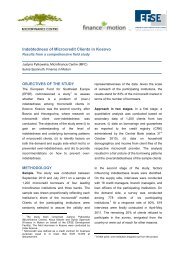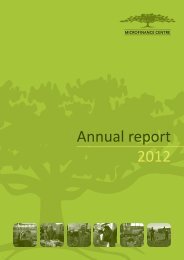Value Chains research report Tajikistan final - Microfinance Centre
Value Chains research report Tajikistan final - Microfinance Centre
Value Chains research report Tajikistan final - Microfinance Centre
You also want an ePaper? Increase the reach of your titles
YUMPU automatically turns print PDFs into web optimized ePapers that Google loves.
This is explained by difference in climate and terrain, as well as usage and training on<br />
new practices, skills and knowledge for beekeepers. Besides, the average yield per bee<br />
family in Sughd Region was more than 61 kg in Sughd Region, reaching over 100 kg for<br />
the most advanced beekeepers. These results work as the best advertisement for the<br />
industry, making it attractive for investment and lending.<br />
Table 51. The productivity of one beehives in <strong>Tajikistan</strong>, kg<br />
2005 2006 2007 2008 2009 2010<br />
<strong>Tajikistan</strong> 23,5 17,7 16,6 15,3 19,3 16,4<br />
Sughd region 14,8 14,3 13,9 17,3 20,2 17,5<br />
Khatlon Region 10,3 61,5 36,0 32,6 49,5 23,3<br />
DNJ 9,0 9,8 10,7 11,9 12,1 13,0<br />
Sources: State Statistic Agency <strong>Tajikistan</strong>.<br />
The average yield of 61.5 kg a year per bee family, as obtained by beekeepers in<br />
Sughd Region, is a good benchmark for all players, and if <strong>Tajikistan</strong> can reach these<br />
average figures, then we will be able to improve return on investment.<br />
According to the official statistics, almost 3000 tons of honeys were harvested in<br />
<strong>Tajikistan</strong> as of the end of 2010; most of this amount was consumed in the domestic<br />
market. This means about 400 g for each resident of the country a year. This figure is<br />
much higher in other countries, measured in kilograms.<br />
The main type of honey harvested in <strong>Tajikistan</strong> is cotton honey. The yield per bee<br />
colony depends on a number of factors, the main of which is the experience of the<br />
beekeeper; other important factors include climate changes in various areas, frequency<br />
of moving between various locations, feeding the bees, and the financial position of the<br />
beekeepers (which affects their mobility). During the <strong>research</strong> beekeepers noted that<br />
the yield is getting worse year after year. Some of the reasons mentioned were as<br />
follows:<br />
• Reduced cotton sowing area;<br />
• The quality and yield of cotton in <strong>Tajikistan</strong> is declining. The impact of this crop<br />
on bee production is substantial, as it is the main crop for producing honey. Low<br />
cotton prices, lack of farmer interest, problems with supply of high-quality seeds<br />
and fertilizers, availability of water and machinery, as well as lack of agricultural<br />
technology, strongly impact the quality of fields and cotton yield;<br />
• Dry spring in mountainous, piedmont and steppe zones;<br />
• Bee diseases:<br />
Foulbrood – infection of bee larvae;<br />
Nosematosis – protozoal parasite developing in bee stomachs;<br />
Varroatosis – tick affecting larvae and adult bees;<br />
Diarrhea.<br />
106




